

|

|
|||

|

|
||
|
Mindset
So, we often get down, we wish things were not as the are and we allow those thoughts to overtake us. And when we do this, we forget what's important. I am reminded of several quotes. Jo Dee Messina said in one of her songs: "It's a beautiful day not a cloud in sight so I guess I'm doin' alright. I got a good old friend here with me tonight and I guess I'm doin' alright." If we have real family and friends with us, supporting us and caring for us, then life is good. Gandhi said: "We must be the change we wish to see." This reminds me that the mindset I am currently experiencing is entirely my choice. And Carlos Castaneda said: "We either make ourselves miserable or we make ourselves strong. The amount of work is the same." So when I feel like I need a mindset alteration, one place I head is the beach (see above). Kind of puts things in perspective. original photo by dmdart Send this link to anyone you think would be interested in reading this entry. |

|
|||

|

|
||
|
Celebrate National Pencil Day!
I, Pencil - My Family Tree as told to Leonard E. Read This is a most wonderful essay, first published in the December 1958 issue of The Freeman. Here is the beginning of this essay: I am a lead pencil - the ordinary wooden pencil familiar to all boys and girls and adults who can read and write. RP.2 Writing is both my vocation and my avocation; that's all I do. RP.3 You may wonder why I should write a genealogy. Well, to begin with, my story is interesting. And, next, I am a mystery - more so than a tree or a sunset or even a flash of lightning. But, sadly, I am taken for granted by those who use me, as if I were a mere incident and without background. This supercilious attitude relegates me to the level of the commonplace. This is a species of the grievous error in which mankind cannot too long persist without peril. For, the wise G. K. Chesterton observed, "We are perishing for want of wonder, not for want of wonders." RP.4 I, Pencil, simple though I appear to be, merit your wonder and awe, a claim I shall attempt to prove. In fact, if you can understand me - no, that's too much to ask of anyone - if you can become aware of the miraculousness which I symbolize, you can help save the freedom mankind is so unhappily losing. I have a profound lesson to teach. And I can teach this lesson better than can an automobile or an airplane or a mechanical dishwasher because - well, because I am seemingly so simple. And here is the last thought challenging paragraph: The lesson I have to teach is this: Leave all creative energies uninhibited. Merely organize society to act in harmony with this lesson. Let society's legal apparatus remove all obstacles the best it can. Permit these creative know-hows freely to flow. Have faith that free men and women will respond to the Invisible Hand. This faith will be confirmed. I, Pencil, seemingly simple though I am, offer the miracle of my creation as testimony that this is a practical faith, as practical as the sun, the rain, a cedar tree, the good earth. Go here to read the wonderfully written and attention grabbing middle (even if you never wondered what goes into making a pencil): http://www.econlib.org/library/Essays/rdPncl1.html Send this link to anyone you think would be interested in reading this entry. |

|
|||

|
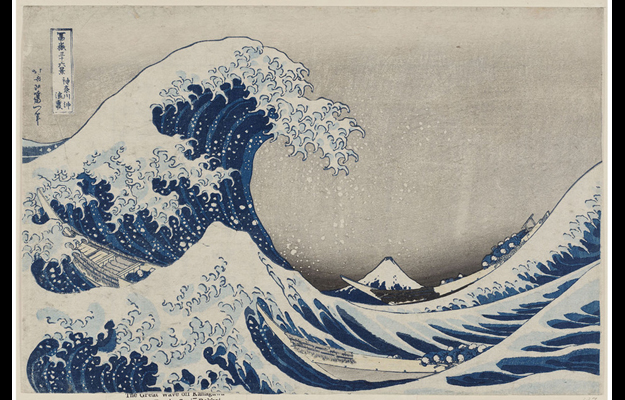
|
||
|
How Hokusai's 'The Great Wave' Went Viral
"The Great Wave," formally titled "Under the Wave off Kanagawa" from the Hokusai series "Thirty-Six Views of Mount Fuji", Katsushika Hokusai's woodblock print from the early 1830s, may be the most famous artwork in Japanese history. The image of a wave towering over Mount Fuji is the subject of a new book and recent exhibits in Paris and Berlin. It is on view in a show at New York's Metropolitan Museum of Art, and another major display is expected at the British Museum in 2017. Starting April 5, the piece takes a starring role in the Museum of Fine Arts, Boston's largest ever exhibition of Japanese prints. The artwork exists in that rare stratosphere of images that are both instantly recognizable and internationally famous. "The Great Wave" has gone viral over time, first circulating the old-fashioned way - via traders and tall ships in the 19th century. Since then, the woodcut has been called an inspiration for Claude Debussy's orchestral work, "La Mer", and appears in poetry and prose by Rainer Maria Rilke, Pearl S. Buck and Hari Kunzru. Levi's and Patagonia used it in marketing campaigns. It has been preserved in cyberspace as a Google Doodle. The work is about the size of a piece of legal paper. The woodblock depicts Mount Fuji, a hallowed place in Japan, but pushes the peak deep into the distance using western perspective. The wave was printed on Japanese mulberry paper but marked by a color new to Japan - a vibrant Prussian blue created from synthetic dye in Germany. ~ excerpt and image from: http://www.wsj.com/articles/how-hokusais-the-great-wave-went-viral-1426698151?utm_content=buffer23d58&utm_medium=social&utm_source=twitter.com&utm_campaign=dailydigest Send this link to anyone you think would be interested in reading this entry. |

|
|||

|
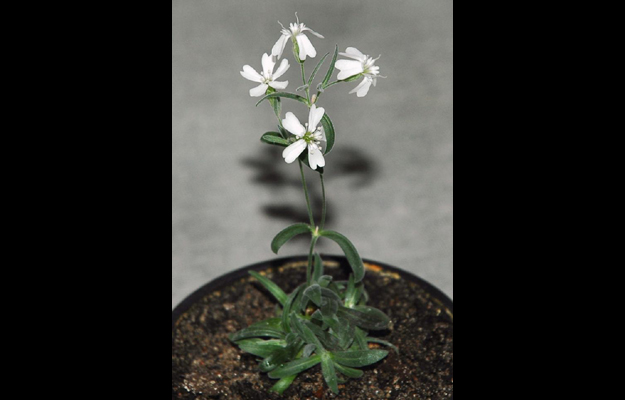
|
||
|
32,000-Year-Old Plant Brought Back to Life
The oldest plant ever to be regenerated has been grown from 32,000 year old seed. A Russian team discovered a seed cache of Silene stenophylla, a flowering plant native to Siberia, that had been buried by an Ice Age squirrel near the banks of the Kolyma River. Radiocarbon dating confirmed that the seeds were 32,000 years old. The mature and immature seeds, which had been entirely encased in ice, were unearthed from 124 feet below the permafrost, surrounded by layers that included mammoth, bison, and woolly rhinoceros bones. The mature seeds had been damaged - perhaps by the squirrel itself, to prevent them from germinating in the burrow. But some of the immature seeds retained viable plant material. The team extracted that tissue from the frozen seeds, placed it in vials, and successfully germinated the plants. The plants - identical to each other but with different flower shapes from modern S. stenophylla - grew, flowered, and, after a year, created seeds of their own. ~excerpt and image from: http://news.nationalgeographic.com/news/2012/02/120221-oldest-seeds-regenerated-plants-science/ Send this link to anyone you think would be interested in reading this entry. |

|
|||

|

|
||
|
Linen Postcards
Linen postcards were printed in the United States from the 1930s until the 1950s. Contrary to their descriptive name, linen postcards were not made out of linen, which is derived from flax, but they did have a high rag content, which means the paper contained a certain amount of cotton fiber. Instead, linen actually refers to the surface texture of the postcard - prior to the early 1930s, it was not economically feasible to print anything of quality on embossed papers. Two of the key traits of linen postcards are their saturated colors, recalling the Phostints produced by the Detroit Photographic Company in the early part of the century, and their soft focus, the result of the cards' uneven surfaces. Many linen postcards also had white borders, a stylistic holdover from the postcards published after World War I and throughout the 1920s. And while many of the artists who were popular during the heyday of the artist-signed-postcards era at the turn of the 19th and 20th centuries are not well represented in linen, most of the major postcard categories are, from comic postcards to scenics (also called "views") to travel and lodging cards, including the popular large-letter postcards. ~excerpt from: http://www.collectorsweekly.com/postcards/linen Send this link to anyone you think would be interested in reading this entry. |

|
|||

|

|
||
|
Edward Burtynsky : Exploring the Residual Landscape
"Nature transformed through industry is a predominant theme in my work. I set course to intersect with a contemporary view of the great ages of man; from stone, to minerals, oil, transportation, silicon, and so on. To make these ideas visible I search for subjects that are rich in detail and scale yet open in their meaning. Recycling yards, mine tailings, quarries and refineries are all places that are outside of our normal experience, yet we partake of their output on a daily basis." "These images are meant as metaphors to the dilemma of our modern existence; they search for a dialogue between attraction and repulsion, seduction and fear. We are drawn by desire - a chance at good living, yet we are consciously or unconsciously aware that the world is suffering for our success. Our dependence on nature to provide the materials for our consumption and our concern for the health of our planet sets us into an uneasy contradiction. For me, these images function as reflecting pools of our times." "[we] come from nature...There is an importance to [having] a certain reverence for what nature is because we are connected to it... If we destroy nature, we destroy ourselves." - EB ~excerpt and image from: http://www.edwardburtynsky.com/ Send this link to anyone you think would be interested in reading this entry. |

|
|||

|
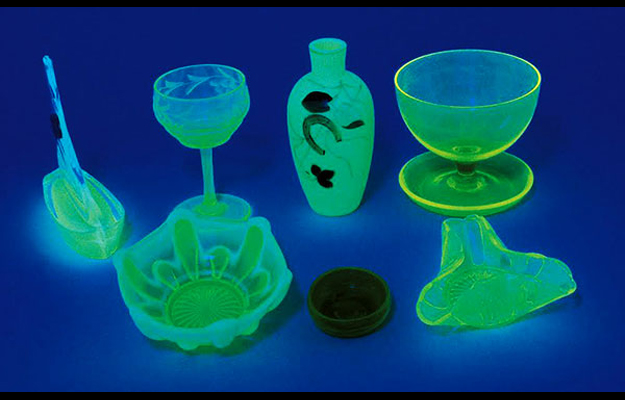
|
||
|
Uranium glass
Uranium or Vaseline glass is glass which has had uranium, usually in oxide diuranate form, added to a glass mix before melting for coloration. Uranium glass was once made into tableware and household items, but fell out of widespread use when the availability of uranium to most industries was sharply curtailed during the Cold War in the 1940s to 1990s The normal color of uranium glass ranges from yellow to green depending on the oxidation state and concentration of the metal ions, although this may be altered by the addition of other elements as glass colorants. Uranium glass also fluoresces bright green under ultraviolet light and can register above background radiation on a sufficiently sensitive Geiger counter, although most pieces of uranium glass are considered to be harmless and only negligibly radioactive. Certain radioactive materials were used in antiques because of their unique color. Antiques containing radioactive material can continue to emit very low levels of radiation for thousands of years, if not longer. Antiques that contain radioactive materials are usually not a health risk if they are in good condition. Canary glass, uranium glass, or Vaseline glass, as it became known in the early 20th century for its similar color to petroleum jelly, emits radiation, but the amounts are tiny, infinitesimal, ridiculously small. Our bodies are subjected to many times more radiation every day. We receive a daily dose of radioactive contamination from the gamma rays that make it through our atmosphere after hurtling through outer space, from the naturally occurring radionuclides present in the ground we walk upon, from the background radiation lingering in the materials used to build the places we call our homes. It's the chemistry of uranium that makes Vaseline glass glow, not radioactivity. It wouldn't make any difference whether the glass contained depleted uranium with the 235 isotope removed or natural uranium; the chemistry is identical. Uranium fluoresces under UV light. ~image and really cool info: http://www.collectorsweekly.com/articles/these-people-love-to-collect-radioactive-glass/ ~other excerpts from: http://en.wikipedia.org/wiki/Uranium_glass http://www.epa.gov/rpdweb01/antiques.html Send this link to anyone you think would be interested in reading this entry. |

|
|||

|

|
||
|
Vernal Equinox
March 20, 2015, is a date that most of us recognize as symbolic of changing seasons. As we welcome spring, people south of the equator are actually gearing up for the cooler temperatures of autumn. Far from being an arbitrary indicator of the changing seasons, March 20 (March 21 in some years) is significant for astronomical reasons. On March 20, 2015, at precisely 6:45 P.M. EDT, the Sun crossed directly over the Earth's equator. This moment is known as the vernal equinox in the Northern Hemisphere. For the Southern Hemisphere, this is the moment of the autumnal equinox. Translated literally, equinox means "equal night". Because the Sun is positioned above the equator, day and night are about equal in length all over the world during the equinoxes. ~excerpt from: http://www.infoplease.com/spot/riteofspring1.html original photo by dmdart Send this link to anyone you think would be interested in reading this entry. |

|
|||

|

|
||
|
The Stewart Gardner Museum Masterpieces
In the early morning hours of March 18, 1990, a pair of thieves disguised as Boston police officers entered the Isabella Stewart Gardner Museum and roamed the Museum's galleries, stealing thirteen works of art. They gained entry into the Museum by posing as Boston police officers and stating that they were responding to a call. The guard on duty broke protocol and allowed them entry through the Museum's security door. The stolen works include: Rembrandt's Storm on the Sea of Galilee (1633), A Lady and Gentleman in Black (1633) and a Self Portrait (1634), an etching on paper; Vermeer's The Concert (1658-1660); and Govaert Flinck's Landscape with an Obelisk (1638); and a Chinese vase or Ku, all taken from the Dutch Room on the second floor. Also stolen from the second floor were five works on paper by the Impressionist artist Edgar Degas and a finial from the top of a pole support for a Napoleonic silk flag, both from the Short Gallery. Edouard Manet's Chez Tortoni (1878-1880) was taken from the Blue Room on the first floor. To mark a somber date, the 25th anniversary of the largest art theft in American history, the Isabella Stewart Gardner Museum has created a "virtual tour" of the 13 items, including paintings by Rembrandt and Vermeer, that were stolen from the museum on March 18th, 1990. The museum has long been reluctant to mark the date, a reminder that there has been little progress in recovering the works, valued at $300 million to $500 million. But the online tour not only marks the anniversary but, perhaps, presents some hope that someone will recognize an image and contribute to an item's return. The online display features panoramic views of the galleries, where blank spaces and empty frames remain, as well as archival photos showing the stolen items, in place, before the heist. ~excerpts and image from: "http://artsbeat.blogs.nytimes.com/2015/03/16/the-gardner-masterpieces-still-missing-but-visible-again-online/?utm_content=buffer76a35&utm_medium=social&utm_source=twitter.com&utm_campaign=dailydigest&_r=0 http://www.gardnermuseum.org/resources/theft Send this link to anyone you think would be interested in reading this entry. |

|
|||

|
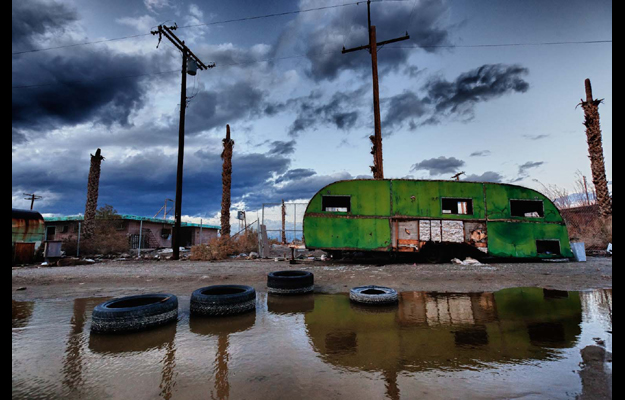
|
||
|
Salton Sea
The Salton Sea is a shallow, saline, endorheic (closed hydrologic systems) rift lake located directly on the San Andreas Fault, predominantly in California's Imperial and Coachella valleys. Its surface is 234 ft below sea level. The deepest point of the sea is 5 ft higher than the lowest point of Death Valley. The modern sea was accidentally created by the engineers of the California Development Company in 1905. In an effort to increase water flow into the area for farming, irrigation canals were dug from the Colorado River into the valley. The Colorado River then punched through poorly constructed levees and flowed for two years into the giant below-sea-level depression.Its waters have no outlet to the ocean, so a century's worth of agricultural runoff and evaporation have left a steadily concentrating brine, made even more noxious by residual fertilizers and pesticides. The lack of an outflow means the Salton Sea is a system of accelerated change. Variations in agricultural runoff cause fluctuations in water level (and flooding of surrounding communities in the 1950s and 1960s), and the relatively high salinity of the inflow feeding the sea has resulted in ever increasing salinity. By the 1960s, the salinity of the Salton Sea was rising, jeopardizing some of the species in it. It has a salinity exceeding 5.0% w/v (saltier than seawater), and most species of fish can no longer survive there. Fertilizer runoffs combined with the increasing salinity have resulted in large algal blooms and elevated bacterial levels. Beginning in the 1930s, developers realized that the populations of Los Angeles and nearby Palm Springs could provide a steady stream of weekend fun seekers. For a while, they were right. Towns sprung up around the shore to cater to fishermen, campers, and boaters. Resorts appeared and did a brisk business, entertaining everyone from Joe Six Pack to the Rat Pack. The influx of runoff reached critical proportions in the 1960s, and the water level began to wildly fluctuate. Whole towns and sections of towns were suddenly waist-deep in ever more saline flooding. Things got so bad that the entire shoreline area of Bombay Beach had to be abandoned in the late 1970s. A 20-foot high berm surrounds the remaining streets and homes of the dilapidated community and its population of 366 remaining homesteaders. ~excerpts and image from: image of the Salton Sea and other really great photographs: http://www.scottcampbellphotography.com/fine-art-photographer/ http://en.wikipedia.org/wiki/Salton_Sea http://www.latimes.com/opinion/editorials/la-ed-salton-sea-20150315-story.html http://www.weirdus.com/states/california/abandoned/salton_sea/ Send this link to anyone you think would be interested in reading this entry. |

|
|||

|
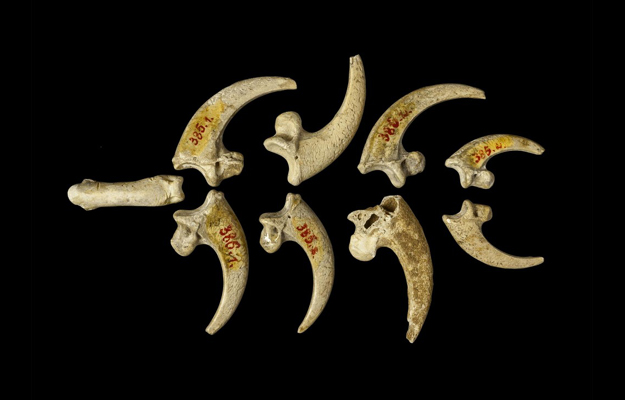
|
||
|
Neanderthal Jewelry?
Examining a piece of primitive jewelry - consisting of eight white-tailed eagle talons - researchers theorize that Neanderthals may have worn the first jewelry roughly 130,000 years ago. Discovered in Krapina, in Croatia, the find suggests that this earliest ancestor of Man may have been more far more creative than we once gave them credit for. The talons appear to have been made into symbolic jewelry roughly 80,000 years before the appearance of modern humans in Europe. Neanderthals are often thought of to be simple-minded mumbling, bumbling, stumbling fools, but the more we know about them the more sophisticated they've become. People often argue that Neanderthals were mimicking modern humans instead of coming up with ornamental things on their own. In this case, there's no doubt: There were only Neanderthals there, and only Neanderthal tools. These talons provide multiple new lines of evidence for Neanderthals' abilities and cultural sophistication. They are the earliest evidence for jewelry in the European fossil record and demonstrate that Neanderthals possessed a symbolic culture long before more modern human forms arrived in Europe. ~excerpt and image from: http://www.piercepioneer.com/was-the-neanderthal-capable-of-making-jewelry-a-new-study-says-yes/38787 Send this link to anyone you think would be interested in reading this entry. |

|
|||

|
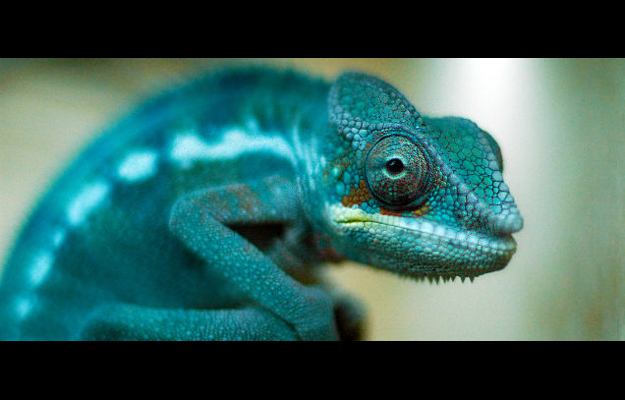
|
||
|
Scientists Have Worked Out How Chameleons Change Color
The changing color of a chameleon's body is an impressive sight - but how it happens has long been a significant scientific question without a compelling answer. Now, researchers have identified a thin layer of deformable nanocyrstals in their skin which gives rise to the phenomenon. A team of scientists from the University of Geneva has observed that chameleons have a layer of skin cells which contain nanocrystals floating within them. Relatively evenly distributed in the cellular matrix, these crystals reflect light at wavelengths - and hence color - related to their spacing. But the researchers have also found that chameleons can change the spacing between crystals. It's this that enables them to change color before our eyes. ~excerpt and image from: http://gizmodo.com/scientists-have-worked-out-how-chameleons-change-color-1690754338 Send this link to anyone you think would be interested in reading this entry. |

|
|||

|

|
||
|
HAPPY PI (Π ) DAY!
Pi Day is celebrated on March 14th (3/14) around the world. Pi (Greek letter Π ) is the symbol used in mathematics to represent a constant - the ratio of the circumference of a circle to its diameter - which is approximately 3.14159. Pi has been calculated to over one trillion digits beyond its decimal point. As an irrational and transcendental number, it will continue infinitely without repetition or pattern. While only a handful of digits are needed for typical calculations, Pi's infinite nature makes it a fun challenge to memorize, and to computationally calculate more and more digits. This year, 2015, Pi Day will have special significance on 3/14/15 at 9:26:53 a.m. and p.m., with the date and time representing the first 10 digits of Π . That same second will also contain a precise instant corresponding to all of the digits of Π . ~excerpts from: http://en.wikipedia.org/wiki/Pi_Day http://www.piday.org/ image: http://www.edn.com/electronics-blogs/now-hear-this/4311969/Happy-Pi-Day-item-2 Send this link to anyone you think would be interested in reading this entry. |

|
|||

|

|
||
|
Virtual Reality Storytelling Is Taking Flight in 2015
Virtual Reality (VR) is a computer-simulated environment that can simulate physical presence in places in the real world or imagined worlds. Virtual reality can recreate sensory experiences, which include virtual taste, sight, smell, sound, and touch. Most current virtual reality environments are displayed either on a computer screen or with special stereoscopic displays, and some simulations include additional sensory information and emphasize real sound through speakers or headphones targeted towards VR users. Some advanced, haptic, systems now include tactile information, generally known as force feedback in medical, gaming and military applications. Furthermore, virtual reality covers remote communication environments which provide virtual presence of users with the concepts of telepresence and telexistence or a virtual artifact (VA) either through the use of standard input devices such as a keyboard and mouse, or through multimodal devices such as a wired glove or omnidirectional treadmills. The simulated environment can be similar to the real world in order to create a lifelike experience The promise of virtual reality has always been enormous. Put on these goggles, go nowhere, and be transported anywhere - throw off the shackles of the mundane through a metaphysical transportation to an altered state. Born of technology, virtual reality at its core is an organic experience. Yes, it's man meets machine, but what happens is strictly within the mind. It had crude beginnings. A definition of virtual reality has always been difficult to formulate - the concept of an alternative existence has been pawed at for centuries - but the closest modern ancestor came to life in the fifties, when a handful of visionaries saw the possibility for watching things on a screen that never ends, but the technology wasn't yet good enough to justify the idea. The promise of the idea was shrouded, concealed under clunky visuals. But the concept was worth pursuing, and others did (especially the military, who have used virtual reality technology for war simulation for years). The utopian ideals of a VR universe were revisited by a small crew of inventors in the late '80s and early '90s. Imagine 10 years ago trying to envision the way we use cellphones today. It's impossible. That's the promise VR has today. VR at its best shouldn't replace real life, just modify it, giving us access to so much just out of reach physically, economically. If you can dream it, VR can make it. It's a medium for progress, not the progress itself. Excerpts and image from: The Verge site is incredibly interesting, actually thrilling, full of the history of VR, where it is now, the companies involved and even how to build your own VR headset: http://www.theverge.com/a/virtual-reality/intro tp://en.wikipedia.org/wiki/Virtual_reality image: http://www.wareable.com/vr/vr-storytelling-reviews-sundance-film-festival Send this link to anyone you think would be interested in reading this entry. |

|
|||

|

|
||
|
Giovanni Ozzola's Industrial and Desert Visions
Ozzola is driven by his interest in our place in the universe - enormous when compared to an ant's, infinitesimal when contextualized by time and outer space - as well as the seemingly ungraspable concept of infinity. He is fascinated by light, which often suffuses his work, or, sometimes, is absent from it. His attention has been focused on light as a necessary material for vision. In the centre of his work he puts the interest for three dimensional space and light. Giovanni Ozzola was born in Florence in 1982. He now lives and works in Tuscany. https://www.artsy.net/post/editorial-giovanni-ozzolas-industrial-and-desert-visions-come?utm_content=bufferb20d8&utm_medium=social&utm_source=twitter.com&utm_campaign=subpost http://www.giovanniozzola.com/biography.html Send this link to anyone you think would be interested in reading this entry. |

|
|||

|

|
||
|
Mockingbird: Mimus polyglottos
Is something keeping you awake these spring nights? Waking you up before sunrise? It seems that there's a lot of activity taking place when most of us expect our birds to be resting. Northern Mockingbirds are well known night callers, especially if there is a full moon or it's breeding season. Enthusiastic mockingbirds can stay up ALL night, mimicking every bird song in the book as well as other sounds such bells, whistles, car alarms, cell phones and sirens. These are birds that can try the patience of the most committed bird-lover! Mockingbirds have landed in South Florida and our state bird is looking for love - at the top of his lungs. Mockingbirds mate from February through August, but most breeding in Florida occurs in the Spring. The mocking bird, or mockingbird was adopted as the Florida state bird by Florida Senate Concurrent Resolution No. 3 approved on April 23, 1927. The northern mockingbird is known for its intelligence and has also been noted in North American culture. A 2009 study showed that the bird was able to recognize individual humans, particularly noting those who had previously been intruders or threats. Also birds recognize their breeding spots and return to areas in which they had greatest success in previous years. The males arrive before the beginning of the breeding season to establish their territories. They use a series of courtship displays to attract the females to their sites. They run around the area either to showcase their territory to the females or to pursue the females. The males also engage in flight to showcase their wings and they sing and call as they perform all of these displays. ~excerpts and image from: http://articles.sun-sentinel.com/2011-05-27/news/fl-noisy-night-mockingbirds-20110527_1_mockingbird-state-bird-migratory-bird-treaty-act http://en.wikipedia.org/wiki/Northern_mockingbird http://www.kcet.org/news/redefine/revisit/wildlife/listen-to-the-mockingbird.html Send this link to anyone you think would be interested in reading this entry. |

|
|||

|

|
||
|
Women (and Beauty?)
International Women's Day is celebrated on March 8 every year. Below is interesting information about this day. Back in the early 1930's Max Factor designed the item in today's image. It represented "perfect facial proportions" and was used in the film industry. The dichotomy between this device and International Women's Day is fascinating and perhaps shows some improved thinking. International Women's Day (IWD), originally called International Working Women's Day, is celebrated on March 8 every year. In different regions the focus of the celebrations ranges from general celebration of respect, appreciation, and love towards women to a celebration for women's economic, political, and social achievements. Started as a Socialist political event, the holiday blended the culture of many countries, primarily in Europe, especially those in the Soviet Bloc. In some regions, the day lost its political flavor, and became simply an occasion for people to express their love for women in a way somewhat similar to a mixture of Mother's Day and Valentine's Day. In other regions, however, the political and human rights theme designated by the United Nations runs strong, and political and social awareness of the struggles of women worldwide are brought out and examined in a hopeful manner. This year's theme, "Empowering Women - Empowering Humanity: Picture It!" envisions a world where each woman and girl can exercise her choices, such as participating in politics, getting an education, having an income, and living in societies free from violence and discrimination. The tortuous looking device in the image is a beauty calibrator or "micrometer", made in 1932 by makeup mogul Max Factor, the father of the modern cosmetics industry. A bizarre union of beauty and phrenology, this one-of-a-kind device was meant to be used as a tool for Hollywood make up artists, who could measure a starlet's face against "perfect" facial proportions and use heavy make up to correct her facial shape flaws. Made of flexible metal strips, it is held against the head using set screws and will supposedly reveal flaws that could be exaggerated on the movie screen. ~ excerpts from 3 Internet sites: http://en.wikipedia.org/wiki/International_Women%27s_Day http://www.un.org/en/events/womensday/ ~ image from: http://ridiculouslyinteresting.com/2013/02/21/what-is-this-thing-mystery-museum-object-5/#more-1852 Send this link to anyone you think would be interested in reading this entry. |

|
|||

|
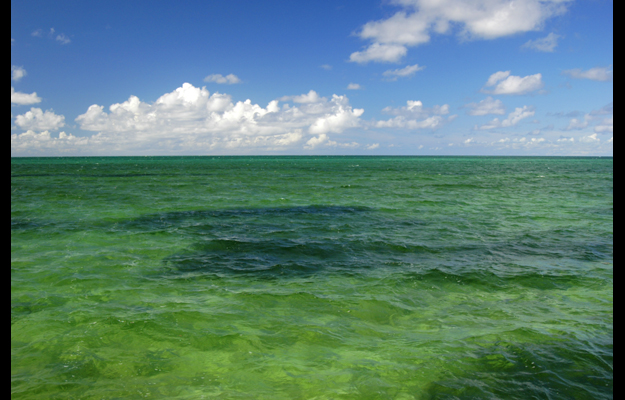
|
||
|
My sister told me: "You should write poems." That comment reminded me of poems I wrote when I was a teenager that were published in our school literary magazine, "The Academe". Even then I was entranced with the beach, shells and all island things. Here is my poem that took top place in poetry in 1967.
Amidst Wandering Thoughts The sand is cool and soft beneath my feet As I walk at random 'neath the midnight sky, A-strewn with diamonds much too pure to buy. The world across the vast expanse of deep, With eyes shut tight, is held in unroused sleep. The daily rains have cleansed the mountains high; The volcanic sand is shifted by the tide, As peaceful waves their silent creatures keep Beyond the eyes of domineering worlds. The sea grapes fan the soil with waxy limbs, While golden clouds the new-found dawn foretell; The glistening sun now beats with brilliance unfurled To praise, aloud and clear with silent hymns, The beauty of the land that it o'er swells. -- Well, maybe it's a bit stilted (I was young), but it shouts my love of the nature of the islands and beaches. original photo by dmdart Send this link to anyone you think would be interested in reading this entry. |

|
|||

|
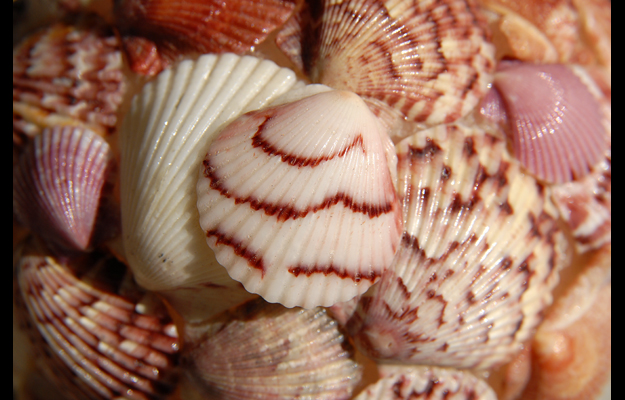
|
||
|
Happy Daylight Savings!
Yesterday was the end of the Sanibel Island Shell Fair. This is an annual event that draws artistic and scientific entries from around the world. One artist traveled from Japan with his amazing entries. I have made portraits of shells over the years. Living on this barrier island, which is ranked the 3rd best shelling location in the world, means that shells are ingrained in my life. Besides walking the beaches admiring, and occasionally collecting, shells, there are shells everywhere, on signs, in names of streets, names of stores, names of restaurants, names of houses, on driveways, on the roads...everywhere. Even after inhabiting these islands part-time and full-time for over 50 years, I am not tired of shells. They are delicate and strong, every color in the universe and the designs are not to be described. And to know that the are alive, grow and change is almost unbelievable. So here is one portrait. original photo by dmdart Send this link to anyone you think would be interested in reading this entry. |

|
|||

|

|
||
|
Abandoned in Key West
Abandoned buildings seem to draw you in. You wonder why they are abandoned, what were they used for, whose lives did they affect, what interesting stories could those walls tell. Whenever I walk past an abandoned building I must photograph it. The historic area of Key West is filled with beautiful restored buildings, lush and colorful landscaping and lots of tourists. This building posed a stark contrast. original photo by dmdart Send this link to anyone you think would be interested in reading this entry. |

|
|||

|
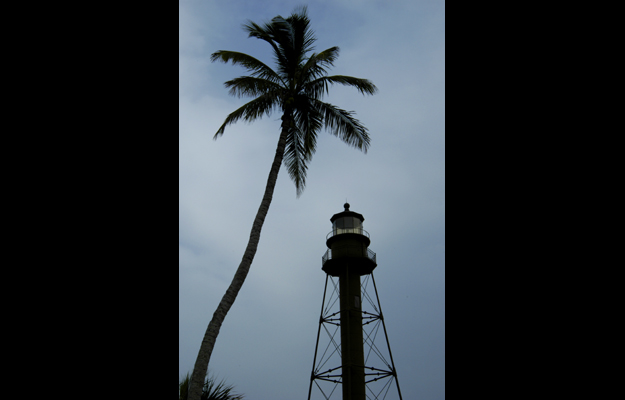
|
||
|
Winter Rain
Southwest Florida doesn't get much rain in the winter. It's our dry season. So when it does rain, we really appreciate the water. The foliage perks up, the rain itself makes lovely sounds on the leaves, the streets and the water, the smell is fresh and the grayness is quieting. Saturday evening the rain left behind 1/2 inch of water. Local landmarks, like the Sanibel Lighthouse, appeared in silhouette and the rain falling on the canal muted man-made sounds. Listen to the rain here: https://www.youtube.com/channel/UC1Dc_nMXr79DmjFTqmOUNMQ original photo by dmdart Send this link to anyone you think would be interested in reading this entry. |

|
|||

|

|
||
|
Bee With No Stripes Discovered in Kenya
It has a black head and a bright orange body, and velociraptor-like claws on its hind legs. It lives underground, not in a hive. And it lives by itself, instead of in the huge colonies we're used to. The world's newest-known bee has been named Samba turkan The hot, dusty bush and deserts of Turkana in Northern Kenya are one of our planet's most remote and exciting regions to explore. This harsh landscape is famous for its long record of human and vertebrate evolution - as part of the work of the Leakey family. The Turkana Basin holds the shimmering Lake Turkana that lies in the middle of the African Great Rift Valley. Turkana is also a region with unique biodiversity, that has adapted to the hot, dry conditions. At first look deserts and drylands may appear bleak and devoid of life. However, nothing could be further from the truth: these regions are teeming with life, but living things here have adapted to the extreme conditions, and often stay hidden or dormant for long periods of time. After brief rains life erupts with an unrivaled exuberance to make the most of the flowers and opportunity. This part of the world is particularly rich in different kinds of bees. Being bright orange, Samba turkan are easy to spot as they zip about the low-growing flowers that appear after the rains. These solitary bees start their day early in the morning racing to the flowers to gather pollen. As things dry up really quickly in the Turkana heat, they only have a couple of days to gather enough pollen for their larvae. The females nest in the ground, digging tunnels in the sand, where they make small cells that hold the stores of pollen and their young. Each female collects food for her own larvae and cares for her own nest individually - there's no sharing and cooperation like in the more familiar honeybees. The female Samba bees lay eggs on the stored pollen. If you're wondering what the males are doing, so are we! We haven't found any yet, but they are likely just focused on mating - we can already see that they don't help at the nest or collect pollen. ~excerpt and photo from: http://voices.nationalgeographic.com/2015/02/25/a-new-bee-from-turkana-kenya/?utm_source=Twitter&utm_medium=Social&utm_content=link_tw20150226voices-beestripes&utm_campaign=Content&sf7662996=1 Send this link to anyone you think would be interested in reading this entry. |
|
|
|
home |
photography |
3d art |
technology |
diverse |
archive |
comments |
dmdart.com |
zebis.com |
sitemap |
contact me by e-mail
|
| © 2014-2015 dmdart.com/blog : a very small division of Zebis, Inc. - All rights reserved. |